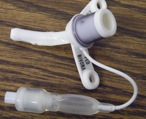Cuffed Tracheostomy Tube
Definition
A cuffed tracheostomy has a balloon around the distal end of the cannula. The balloon forms a seal between the tracheostomy tube and the trachea when the cuff is inflated.

 Used to:
Used to:
- Prevent an air leak around the trach tube when the child is connected to positive pressure ventilation
- Reduces aspiration of secretions from the upper airway
- Cuffed-soft plastic balloon around the outside of the lower end of the cannula
- Cuff inflation line - very small tubing that connects the cuff internally and the pilot balloon externally to provide a way to inflate and deflate the trach tube cuff
- Pilot balloon –small external balloon that shows if the cuff is inflated or deflated
- does not show how much air is in the cuff
- Do not squeeze the pilot balloon, as that will increase the pressure on the child's airway
- Valve – a spring loaded one way valve used to put air into or pull air out of the cuff using a syringe
- Push the syringe straight in and out
- Twisting the syringe into the valve will break it


| Air cuffed tube - high volume, low pressure | |
|
| Tight-to shaft tube - high pressure, low volume | |
|
| Foam cuffed tube - high volume, low pressure | |
|
- Complications resulting from excessive pressure on the tracheal wall include:
- Ischemic necrosis leading to stenosis
- Ulceration and softening of the cartilage leading to tracheomalacia and dilation
- Tracheal rupture, perforation, scarring or fistula
- The volume of air or water to instill into the cuff will be ordered by the physician
- Do not exceed the ordered volume
- With the cuff inflated, the only route of effective air exchange is through the tracheostomy tube because air will not be able to flow freely past the exterior wall of the trach tube
- A speaking valve cannot be used with an inflated cuffed tracheostomy tube
 Cylinder shaped plastic softens at body temperature
Cylinder shaped plastic softens at body temperature
 Air permeable plastic
Air permeable plastic
